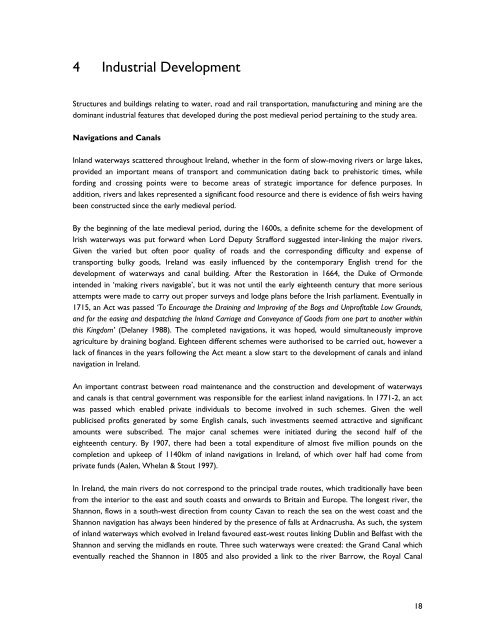archaeological & built heritage assessment - The Heritage Council
archaeological & built heritage assessment - The Heritage Council
archaeological & built heritage assessment - The Heritage Council
Create successful ePaper yourself
Turn your PDF publications into a flip-book with our unique Google optimized e-Paper software.
4 Industrial Development<br />
Structures and buildings relating to water, road and rail transportation, manufacturing and mining are the<br />
dominant industrial features that developed during the post medieval period pertaining to the study area.<br />
Navigations and Canals<br />
Inland waterways scattered throughout Ireland, whether in the form of slow-moving rivers or large lakes,<br />
provided an important means of transport and communication dating back to prehistoric times, while<br />
fording and crossing points were to become areas of strategic importance for defence purposes. In<br />
addition, rivers and lakes represented a significant food resource and there is evidence of fish weirs having<br />
been constructed since the early medieval period.<br />
By the beginning of the late medieval period, during the 1600s, a definite scheme for the development of<br />
Irish waterways was put forward when Lord Deputy Strafford suggested inter-linking the major rivers.<br />
Given the varied but often poor quality of roads and the corresponding difficulty and expense of<br />
transporting bulky goods, Ireland was easily influenced by the contemporary English trend for the<br />
development of waterways and canal building. After the Restoration in 1664, the Duke of Ormonde<br />
intended in ‘making rivers navigable’, but it was not until the early eighteenth century that more serious<br />
attempts were made to carry out proper surveys and lodge plans before the Irish parliament. Eventually in<br />
1715, an Act was passed ‘To Encourage the Draining and Improving of the Bogs and Unprofitable Low Grounds,<br />
and for the easing and despatching the Inland Carriage and Conveyance of Goods from one part to another within<br />
this Kingdom’ (Delaney 1988). <strong>The</strong> completed navigations, it was hoped, would simultaneously improve<br />
agriculture by draining bogland. Eighteen different schemes were authorised to be carried out, however a<br />
lack of finances in the years following the Act meant a slow start to the development of canals and inland<br />
navigation in Ireland.<br />
An important contrast between road maintenance and the construction and development of waterways<br />
and canals is that central government was responsible for the earliest inland navigations. In 1771-2, an act<br />
was passed which enabled private individuals to become involved in such schemes. Given the well<br />
publicised profits generated by some English canals, such investments seemed attractive and significant<br />
amounts were subscribed. <strong>The</strong> major canal schemes were initiated during the second half of the<br />
eighteenth century. By 1907, there had been a total expenditure of almost five million pounds on the<br />
completion and upkeep of 1140km of inland navigations in Ireland, of which over half had come from<br />
private funds (Aalen, Whelan & Stout 1997).<br />
In Ireland, the main rivers do not correspond to the principal trade routes, which traditionally have been<br />
from the interior to the east and south coasts and onwards to Britain and Europe. <strong>The</strong> longest river, the<br />
Shannon, flows in a south-west direction from county Cavan to reach the sea on the west coast and the<br />
Shannon navigation has always been hindered by the presence of falls at Ardnacrusha. As such, the system<br />
of inland waterways which evolved in Ireland favoured east-west routes linking Dublin and Belfast with the<br />
Shannon and serving the midlands en route. Three such waterways were created: the Grand Canal which<br />
eventually reached the Shannon in 1805 and also provided a link to the river Barrow, the Royal Canal<br />
18
















